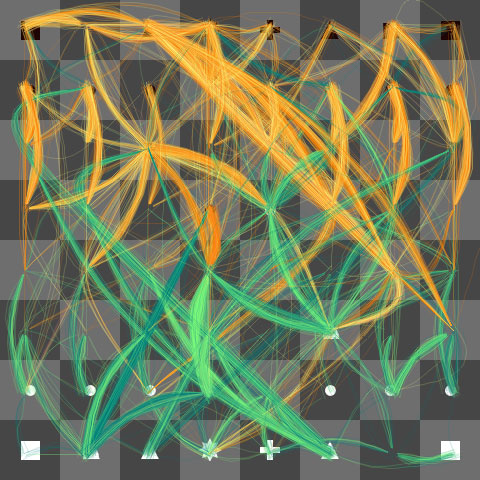
Slate currently has a slideshow that gives a brief introduction into the use of Information Visualization in modern art. Information Visualization is concerned with displaying incredibly large amounts of data in an intuitive way that highlights interesting properties of the data in an easy to analyze format. Due to both the aesthetic quality of these visualizations and the informational value inherent in them, it is no surprise that such work can be interpreted in an artistic fashion.
The image in the slideshow, that particularly piqued my interest - due in no small part to the fact that the application is tangentially related to my research area - is a system that visualizes the reasoning done by a computer chess program called the Thinking Machine 4. In the picture above taken from the system's website, a large number of lines of play are depicted for each player simultaneously, with green arcs indicating the possible movement of players by white (on the bottom), and the orange arcs depict possible plays by the black player (on the top). The lighter the arc, the better the move is believed to be by the program for the white player (and consequently the worse it is believed to be for black). Anyone is free to play the available chess-playing program and watch it "think" in real-time.
From what I can gather from the authors' website, the playing ability of the program has been set to allow it to be easily defeated by reasonable chess players. However, the algorithm at the program's core, minimax search, is just a simplified version of the system which is the basis of all of the strongest chess-playing programs currently out there, as well as the famous Deep Blue.
Essentially, minimax search works by considering every possible state that the board can be in, some number of moves into the future. This number is generally small due to the incredibly high number of possible board states, and the limit on reasoning time imposed by the rules of chess. In the above image, all future board states, up until some depth, are represented simultaneously - each being the result of the combination of some number of arcs.
Each future board state is then evaluated, using expert knowledge about chess that has been programmed in by the system designer. The program then selects the move which pushes the game towards the best board state it can get to, assuming the opponent is trying to oppose this goal.
What is particularly interesting about this image is that it illustrates that the computer is reasoning about the game in a completely different way than any human would. While a human player does in fact peer into the future when constructing a strategy, at each step only a small number of moves are considered for any one player. This is not only because the human is unable to consider such a large number of board states in such a small period of time, but also because the human is remarkably effective at immediately recognizing that most of the moves can be disregarded.
The program, as the image suggests, is much more thorough in its approach. As such, it is forced to consider many unpromising moves because it lacks any intuition, thereby limiting how far into the future it can plan. On the flip side, the computer is more willing to consider unorthodox play, and is never going to mistakenly disregard a line play due to any bias for move removal.
Many people believe that the top human players and the top computer players are about on par in the world of chess. As such, this visualization not only highlights the thoroughness of the computerized approached to chess, but it also provices a beautiful reminder that usually "there is more than one way to skin a cat."
For the sake of brevity, I have kept the description of minimax as non-technical as possible. The interested reader should look into a more complete description of the algorithm and its game theoretic properties. There are also many enhancements which increase the quality of the search, such as alpha-beta pruning and quiescence (both used by Thinking Machine 4), which try to help avoid unpromising lines of play.


